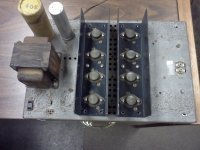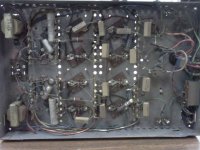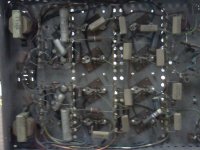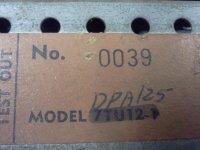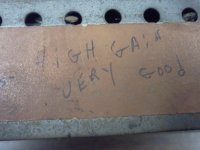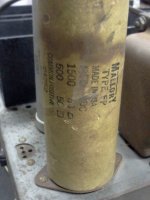New member here,
I am starting to get into the old audio hobby in hopes of building tube amps. I just bought off Ebay a strange amp I have attached pictures in hopes that some of you with a lot more expertise can tell me what the he😕😕 i have bought.
The plus side is I have very little invested, less than $15.00 dollars, not much to loose. The negative is that it does not seem to amplify sound by much.
Here is what I know. The transistors are RCA 2n2147 there are 8 of them. I believe they were 25 watts each??? should be 100 watts a channel??? The chassis has lables that show a model 7tu12-1 inked over and a hand written DPA/25 serial number 0039. I believe this is a bastard Packard Bell.
Any ideas on the lack of volume, Bad caps ? transistors shot? the sound is clear just not a lot of it.
Thanks Mark
I am starting to get into the old audio hobby in hopes of building tube amps. I just bought off Ebay a strange amp I have attached pictures in hopes that some of you with a lot more expertise can tell me what the he😕😕 i have bought.
The plus side is I have very little invested, less than $15.00 dollars, not much to loose. The negative is that it does not seem to amplify sound by much.
Here is what I know. The transistors are RCA 2n2147 there are 8 of them. I believe they were 25 watts each??? should be 100 watts a channel??? The chassis has lables that show a model 7tu12-1 inked over and a hand written DPA/25 serial number 0039. I believe this is a bastard Packard Bell.
Any ideas on the lack of volume, Bad caps ? transistors shot? the sound is clear just not a lot of it.
Thanks Mark
Attachments
it looks like something from the bad old days of early solid state, where they were just dropping transistors straight into tube-type designs. Those are power Germanium transistors. They've probably all developed significant leakage by now.
If you want to build tubes, the transformers will probably still be good.
If you want to build tubes, the transformers will probably still be good.
You know, I've seen equipment such as this by RCA. It used 4 TO66 in the output. It was a line amplifier and would put out about 8dB on eight outputs. It operated off a 50 VAC transformer and was balanced audio in and out. I think the model was BA40.
Looks like a juke box amplifier from the very early sixties.
Maybe crap from a pure quality point of view, but very valuable vintage item.
Don't dismantle it, try to repair it.
Transistors are not necessarily out of order, but a number of lytics certainly are
Maybe crap from a pure quality point of view, but very valuable vintage item.
Don't dismantle it, try to repair it.
Transistors are not necessarily out of order, but a number of lytics certainly are
This is likely also a pure power stage which mean you need a separate driver and gain stage to make a complete amplifier.
gawd this thing is ugly! Elvee is propably right. I would show the pix to people who repair old jukeboxes. They may be able to recognize the amp. Other than the electrolytics I would also replace the carbon comp resistors. E
Not suitable for tube application - best sold as-is to someone who recognizes it and can use it, for whatever $$ you can get...
I was going to say maybe an old Organ amp... but jukebox is the same sort of thing...
_-_-bear
I was going to say maybe an old Organ amp... but jukebox is the same sort of thing...
_-_-bear
I've a couple similar out of consoles. The most interesting bit are the phase split transformers on the front end.
dave
dave
To spell out the abbreviation referred to by elvee, the electrolytic capacitors are certainly dried up. Everybody bad mouths the lack of bass & treble on my organ (manufactured 1968), but replacing 2 can electrolytic capacitors doubled the volume and added some bass. Replacing 2 more tripled the volume again, added a whole lot of bass, and made the percussion feature work. Your tall can cap is historic, but probably too low in voltage to be bought now as a tall can from FP caps at tubesandmore.com and triodeelectronics.com. New electrolytic capacitors are a lot smaller and axial or radial, so you can fit them on headers under the chassis invisibly. You get headers from electronicssurplus.com (connection button) or tubesandmore.com (connections, they call them "terminal strips", oddly, which name everybody else uses for screw strips). The plus of the replacement caps go to the circles, moons, and triangle wires on your can caps. You should disconnect the wires from the old cans, as they can explode due to short circuit in a dried out condition. Fresh electrolytics are available from T&m,triode, also newark.com and mouser.com. If you intend to keep it, buy electrolytic caps rated at 2000 hours or higher. My feeling is that E-bay capacitors will be stale or rejects, but it is your money. Electrolytic replacements should be no higher in voltage than 140% of the old one, but can be 150% higher than the old one in value if not used for frequency filtering applications (where they will be +-10% tolerance, not the standard bypass +80-20%). Read about discharging capacitors and removing jewelry etc in the hV safety sticky thread at the top of the tube forum, as this thing is so old it probably has lethal voltages stored in the caps (greater than 24VDC).
For a cheap but pleasing front end, you can look at a used mixer (using op amps) before buying an expensive "preamp". If from a jukebox, this probably connected to a piezo record eating phono cartridge, that put out at least 1 VAC. Several mixer plans are on the analog line level thread, and used band and disco mixers can be upgraded with better op-amps and power supply filtering.
For a cheap but pleasing front end, you can look at a used mixer (using op amps) before buying an expensive "preamp". If from a jukebox, this probably connected to a piezo record eating phono cartridge, that put out at least 1 VAC. Several mixer plans are on the analog line level thread, and used band and disco mixers can be upgraded with better op-amps and power supply filtering.
Last edited:
I am in the jukebox game, and I don;t recognize it. But jukebox was still my first guess.
And as someone pointed out, this is just a power amp, so that explains the lack of gain.
terminology changes over time, but to me:
Barrier strip:
Terminal strip:
And as someone pointed out, this is just a power amp, so that explains the lack of gain.
terminology changes over time, but to me:
Barrier strip:
An externally hosted image should be here but it was not working when we last tested it.
Terminal strip:
An externally hosted image should be here but it was not working when we last tested it.
OK, recapped the outputs side, sounds much better, drives my JBL's pretty well. I will recap the power side this week, but was hoping someone could point me towards a simple and cheap method to control the volume output.
Well, this guy is really cheap and domestic. NightFire Electronic Kits : (#1130) Analog IC DIP-Only Design Kit #3 - $9.99 He doesn't wire the kit up, you would have to wire up a circuit like http://www.diyaudio.com/forums/analog-line-level/177393-diy-dj-mixer.html but you don't need that many inputs. 741's are a bit noisy, 4558's are better but require more power supply decoupling and x nf caps around the feedback resistors. 4560's and 33078 are better yet, and need even more decoupling. If you want a canned solution, tonepad.com has a canned microamp pcb for $11 but he doesn't put any power decoupling on the pcb, you have to remember to do it yourself and drill your own holes. For a split 120 vAC power supply I use a 18 VDC wall transformer from salvation army for $1 with two 1n5344 voltage regulators, 22 ohm in resistors and assorted capacitors in and out for a +- 8VDC power supply, on lumberyard lexan I drilled myself. See http://www.diyaudio.com/forums/anal...improving-disco-mixer-mid-fi-performance.html for power supply schematic.
- Status
- Not open for further replies.
- Home
- Amplifiers
- Solid State
- Strange old amp???
